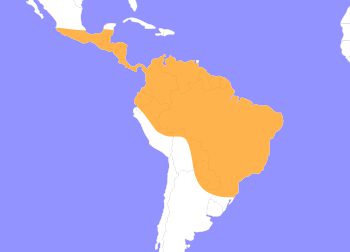Green Iguana
Iguana iguana
Green Iguanas are also found in southern parts of the United States ranging. They are considered to be invasive species to parts of southern Florida, Hawaii, Virgin Islands, and Rio Grande Valley of Texas. They are the largest known lizard to occur in the United States. They spend most of their time at the tops of trees where they can bask in the sun. They only come down to lay eggs. Iguanas are very good swimmers and will dive down to avoid predators.
Green iguanas can sometimes be a blueish color and be banded or a blotchy brown as juveniles. Adults tend to be one solid color and become darker, almost brown in color. The color can change for an individual because of mood, temperature, health or even social status. Males experience more color changes than females. Other stand out features include their spiny crest that starts at their neck and goes all the way down to the base of their tail. They also have a dewlap (loose skin on their throat) for thermoregulation and large cheek scales below their ear membranes. Lastly, they have a third eye called a parietal eye in the middle of the top of their head. This is not used for vision, but rather detection of light above them and hormone regulation.
Say Hello To Cub Creek's Iguana: Chaos
Chaos is our Green Iguana and you can find him in the Reptile Room. He is only a couple years old, so he is still very small and bright green. He loves hiding among his plants, especially up on the top of his tree (just like wild iguanas will do!) Being young, he is not used to being handled very often, but that is nothing some practice and gentle care can’t fix.

Green Iguanas range over large areas of Central and South America, from Mexico to Paraguay.
HABITAT -They live high in the tree canopy of rainforests; can also be found in some swamps and brackish water.
DIET -They are herbivorous, preferring leafy greens or fruit, though sometimes they eat carrion.
FUN FACT -Young iguanas will group together to help each other avoid predation.
SOCIAL BEHAVIOR -Besides youths and mating season, they are solitary animals. Males can be territorial.
ACTIVITY -They are diurnal; basking in the sun helps them digest better.
PREDATORS -Iguana predators include hawks, large birds, and humans.
SIZE -Full grown adults weigh around 15 lb and reach about 6 ft in length.
RELATIVES -They are in the same family as the Marine Iguana and the Northern Chuckwalla.
CONSERVATION -The IUCN has them listed as no special status.
Cub Creek Animal Care Information
Housing - Chaos is housed in the Reptile Room where the rest of our lizards and snakes are also kept. He lives in large heat and UV light-controlled enclosure filled with artificial plants to mimic their tropical environment. Fresh water and plenty of places to hide, explore, and bask are provided for him.
Diet - Chaos is still in his juvenile growing stage and is fed fresh food every day. He is given apple, shredded sweet potato, and chopped greens supplemented with a calcium powder in order to give him all the necessary nutrients he needs to be healthy. Various other fruits and vegetables are given to him for additional nutrients.
Enrichment - Most of the enrichment we give our lizards comes from handling and socializing them and being in a multispecies enclosure. In the summer, they get held daily and sometimes even brought outside when it is warmer. During the offseason, Animal Interns can be found carrying them around on their shoulders as they work!

